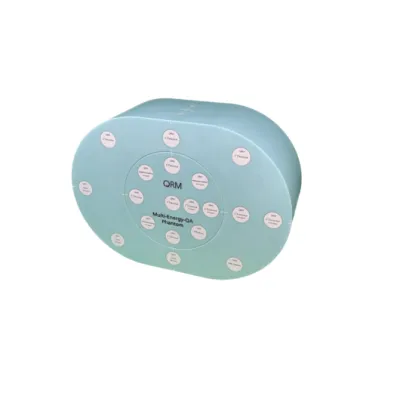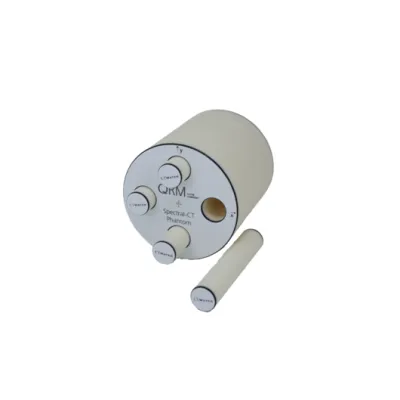

QRM products
Diagnostic Imaging - Image Quality Phantoms
QRM - Multi-Energy QA Phantom for CT Protocol Testing
The Multi-Energy QA Phantom from QRM is specifically designed for testing CT systems employing dual-energy, multi-energy, or photon-counting methodologies. This phantom is pivotal for optimizing image acquisition and processing across multiple energy levels, thereby enhancing the visualization capabilities in computed tomography (CT). The phantom features a removable head (160 mm diameter) with ten holes for various inserts and a body available in either oval or circular configurations. Both the head and body are made from CTwater, a water-equivalent material. It includes a set of 26 inserts containing different contrast media like iodine and calcium hydroxyapatite, each at varying concentrations, alongside soft tissue-equivalent materials such as those mimicking adipose, liver, and brain tissues based on ICRU Reports 44 and 46. Optional configurations include inserts with reduced material diameter embedded in a water-equivalent shell. Technical specifications include measurements for physical density, concentration, and electron density relative to water with an accuracy of ±5 HU from specified values.
QRM - Spectral CT Phantom for Dual-Energy and Photon-Counting CT Modalities
The Spectral CT Phantom by QRM is a specialized tool designed for testing various CT modalities including dual-energy, multi-energy, and photon-counting setups. This phantom is housed in a 100 mm cylinder with eight 20 mm diameter holes to accommodate different solid rods and fillable tubes. It supports the evaluation with water or contrast media. The set of solid rods available includes materials with varying concentrations of Iodine and Ca-Hydroxyapatite (CaHA), as well as equivalents for various tissues such as water, adipose, muscle, bone, and lung, following specifications in ICRU Report 44 and 46. Key technical parameters include mass density, electron density, and effective atomic number for all materials. The device maintains accuracy within ±5 HU of specified values, though nominal values may vary based on manufacturing methods and the imaging device used. This makes it an ideal choice for precise calibration and testing of CT imaging systems.


